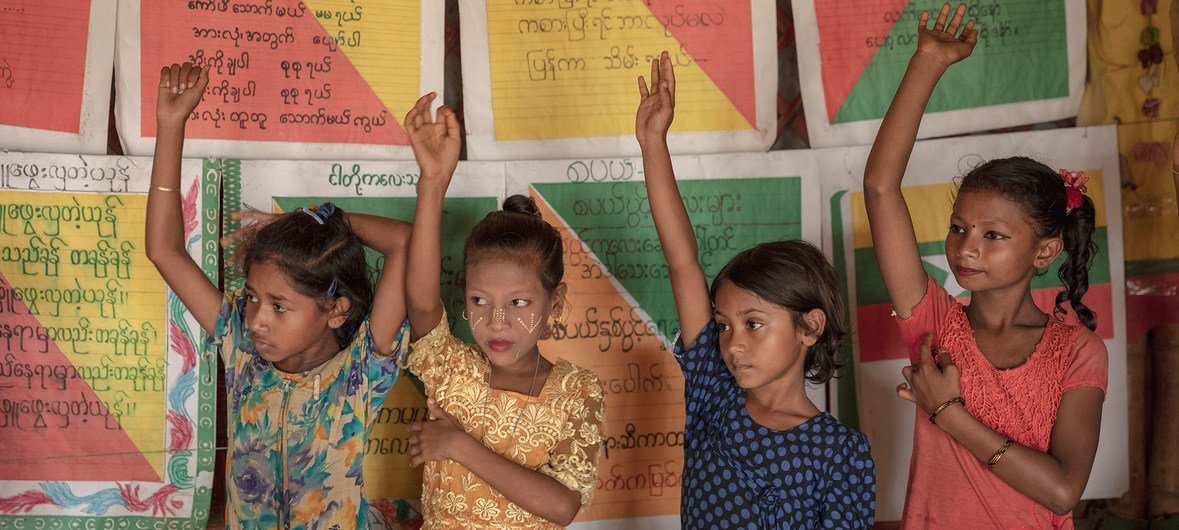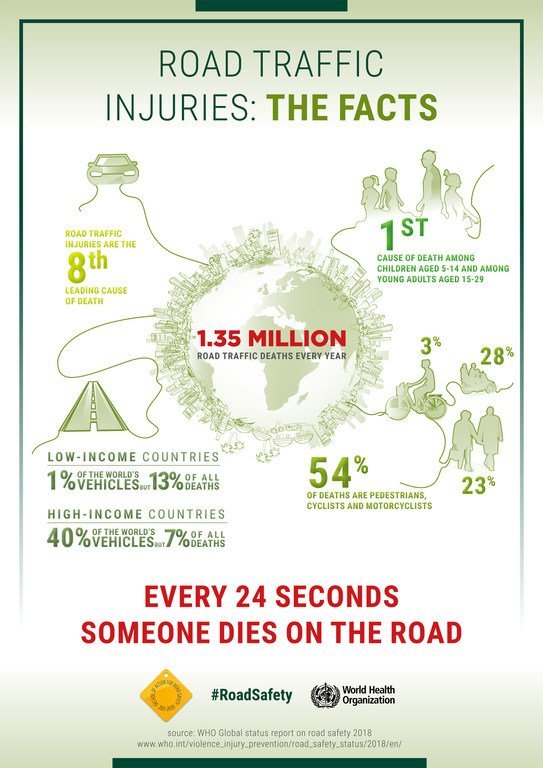Wednesday, March 04, 2020
PROF SULEMAN BOGORO FINGERS HIS FORMER BOSS, PRESIDENT GOODLUCK JONATHAN IN MISSING N359B TETFUND MONEY
Saturday, February 01, 2020
ASUP disgruntled over unpaid salaries, sack of 200 Abia Poly staff and IPPIS Implementation delay
The academic staff union of Polytechnics, ASUP has described as barbaric the action of the Abia state government for disengaging two hundred staff, despite owing them between thirteen and seventeen months salaries
Monday, November 18, 2019
UNICEF reports uneven progress in 30 years of child rights treaty ahead of World Child Day

Monday November 18, 2019
Although the world has made historic gains over the past three decades in improving children’s lives, urgent action is required if the poorest children are to feel the impact, a new UN report published on Monday warns.
The study by the UN Children’s Fund (UNICEF) calls on countries to recommit to promises made under the Convention on the Rights of the Child, adopted 30 years ago.
Henrietta Fore, UNICEF Executive Director, noted that while increasing numbers of children are living longer, better and healthier lives, the odds continue to be stacked against the poorest and most vulnerable.
"In addition to the persistent challenges of health, nutrition and education, children today have to contend with new threats like climate change, online abuse and cyberbullying," she said.
"Only with innovation, new technologies, political will and increased resources will we help translate the vision of the Convention on the Rights of the Child into a reality for all children everywhere."
Uneven progress, emerging threats
The Convention on the Rights of the Child is the most widely and rapidly adopted international treaty in history, and has been ratified by more than 190 countries.
It acknowledges childhood, which lasts through age 18, as a special time in which children must be allowed to grow, learn, play, develop and flourish with dignity.
UNICEF reported that since its adoption, the global rate for under-five mortality has dropped by around 60 per cent, while the proportion of undernourished children has almost halved.
The Convention has also influenced numerous constitutions, laws and policies that reflect its guiding principles, which include non-discrimination, the right to protection and acting in the best interests of the child.
However, the report shows that progress has not been even.
UNICEF said the world’s children continue to confront age-old threats while new hazards loom over their future.
The poorest children are still likely to die from preventable causes before reaching their fifth birthday. Millions of the most disadvantaged are still at risk due to poverty, discrimination and marginalization. At the same time, cases of the childhood killer measles are on the rise as immunization coverage rates have slowed down since 2010.
Progress in education also is dismal. The report reveals that the number of primary level children out of school has remained static for more than a decade.
"Many of those who are in school are not learning the basics, let alone the skills they need to thrive in today’s economy," UNICEF added.
In recent years, young people have been speaking up and calling for action to address climate change. UNICEF said they are the ones most at-risk.
"Rapid changes in climate are spreading disease, increasing the intensity and frequency of extreme weather events, and creating food and water insecurity. Unless urgent action is taken, the worst for many children is yet to come," the UN agency warned.
Inclusive dialogue planned
UNICEF believes that where there is political will and determination, children’s lives improve, as documented by the report, which has been released ahead of World Children’s Day on 20 November.
The study calls for more data and evidence to accelerate progress and advance child rights, alongside recommendations such as involving young people in creating solutions.
UNICEF will use the coming 12 months to promote an inclusive global dialogue aimed at making the promise of the convention a reality for all children.
As Ms. Fore, the UNICEF chief, stated: "The Convention stands at a crossroads between its illustrious past and its future potential. It is up to us to recommit, take decisive steps and hold ourselves accountable."
SUPPORT THIS EFFORT. Email: patrickabuluose@gmail.com
NEWS TRACKER: PAST STORIES ON THIS ISSUE
Sunday, November 17, 2019
Road Safety Crisis: UN calls for action to tackle ‘ubiquitous but invisible’ global road safety crisis

Saving lives by improving road safety is “one of the many objectives of the 2030 Agenda for Sustainable Development”, the United Nations chief said in his message for the global day set aside for remembering the victims of traffick accidents.
Noting that more than 1.3 million people die in road accidents every year, Secretary-General António Guterres pointed out that more young people between the ages of 15 and 29 die from road crashes annually than from HIV/AIDS, malaria, tuberculosis or homicide.

“The World Day of Remembrance of Road Traffic Victims is an opportunity to reflect on how we can save millions of lives,” he said.
And since 2015, his Special Envoy on Road Safety, Jean Todt, has worked to mobilize political commitment, raise awareness about UN road safety conventions, foster dialogue on good practices and advocate for funding and partnerships.
“While the scale of the challenge is enormous, collective efforts can do much to prevent these tragedies”, the UN chief attested.
In 2018, a UN Road Safety Fund was launched to finance actions in low- and middle-income countries, where around 90 per cent of traffic casualties occur.
And next February, a global ministerial conference on road safety will be held in Sweden to strengthen partnerships to accelerate action.
“Urgent action remains imperative”, concluded the Secretary-General. “On this World Day, I call on all to join forces to address the global road safety crisis.”
‘Ubiquitous yet invisible’
The UN Department of Safety and Security (DSS) calls road traffic crashes a ‘hidden epidemic’.
According to DSS, they have a “dramatically transformative impact” on people’s lives with most causalities remaining “almost invisible to society at large”.
Last February, with the participation of UN leaders from the Secretariat, UN Development Programme (UNDP), UN Population Fund (UNFPA) and others, including the Chef de Cabinet and Special Envoy on Road Safety, the UN launched the Road Safety Strategy in New York and Geneva that showed unity and the shared message of road safety across the UN-system.
The Day has become an important tool in efforts around the world to reduce road casualties.
It offers an opportunity to draw attention to the scale of emotional and economic devastation road crashes cause and recognizes the suffering of victims and the work of rescue services.
Ending fatal road crashes are in line with the 2030 Agenda, particularly in line with Sustainable Development Goal 3 (SDG 3), which encompasses good health and wellbeing and SDG 11 on sustainable cities and communities.
Five pillars of road safety
Pillar 2: Safer vehicles
Pillar 3: Safer road user behaviour
Pillar 4: Post-crash responses
Pillar 5: Safer driving environment
This takes leadership in demonstrating outstanding road safety behavior every day and working together to find the best solutions.
NEWS TRACKER: PAST STORIES ON THIS ISSUE
UN calls for action to tackle ‘ubiquitous but invisible’ global road safety crisis

Saving lives by improving road safety is “one of the many objectives of the 2030 Agenda for Sustainable Development”, the United Nations chief said in his message for the global day set aside for remembering the victims of traffick accidents.
Noting that more than 1.3 million people die in road accidents every year, Secretary-General António Guterres pointed out that more young people between the ages of 15 and 29 die from road crashes annually than from HIV/AIDS, malaria, tuberculosis or homicide.

“The World Day of Remembrance of Road Traffic Victims is an opportunity to reflect on how we can save millions of lives,” he said.
And since 2015, his Special Envoy on Road Safety, Jean Todt, has worked to mobilize political commitment, raise awareness about UN road safety conventions, foster dialogue on good practices and advocate for funding and partnerships.
“While the scale of the challenge is enormous, collective efforts can do much to prevent these tragedies”, the UN chief attested.
In 2018, a UN Road Safety Fund was launched to finance actions in low- and middle-income countries, where around 90 per cent of traffic casualties occur.
And next February, a global ministerial conference on road safety will be held in Sweden to strengthen partnerships to accelerate action.
“Urgent action remains imperative”, concluded the Secretary-General. “On this World Day, I call on all to join forces to address the global road safety crisis.”
‘Ubiquitous yet invisible’
The UN Department of Safety and Security (DSS) calls road traffic crashes a ‘hidden epidemic’.
According to DSS, they have a “dramatically transformative impact” on people’s lives with most causalities remaining “almost invisible to society at large”.
Last February, with the participation of UN leaders from the Secretariat, UN Development Programme (UNDP), UN Population Fund (UNFPA) and others, including the Chef de Cabinet and Special Envoy on Road Safety, the UN launched the Road Safety Strategy in New York and Geneva that showed unity and the shared message of road safety across the UN-system.
The Day has become an important tool in efforts around the world to reduce road casualties.
It offers an opportunity to draw attention to the scale of emotional and economic devastation road crashes cause and recognizes the suffering of victims and the work of rescue services.
Ending fatal road crashes are in line with the 2030 Agenda, particularly in line with Sustainable Development Goal 3 (SDG 3), which encompasses good health and wellbeing and SDG 11 on sustainable cities and communities.
Five pillars of road safety
Pillar 2: Safer vehicles
Pillar 3: Safer road user behaviour
Pillar 4: Post-crash responses
Pillar 5: Safer driving environment
This takes leadership in demonstrating outstanding road safety behavior every day and working together to find the best solutions.





